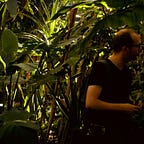Invisible neighbourhoods
When we create networks we often think of nodes as neighbours because of their closeness on the canvas. Nodes, connected by edges consist this species of visualization whether that be real or unreal entities. A good example is the city, where we have roads that have intersections that connect to other roads, and we also have different public transportation systems, that also can be thought of as networks. But not just the roads can make up a network, since there is a specific type of network representation called adjacency matrix, where the network is “flatten out” and only the edges between the nodes are recorded. This type of representation is quite different of what we got used to, it looks like a matrix. Rows and columns, that denote nodes, and the cell values represent the connection between them. If there is value in the cell. If not — there is no connection between those nodes.
So, what happpens when one wanders around the city, head filled with networks and matrixes, it’s easy to try to connect to the surroundings and understand that there are adjacency matrixes too, not just “simple” network structures as we used to think of roads etc. But what are these matrixes? Living in a postsocialist country, the answer must be self evindent for some of us but not for others. When we look around there is a specific type of architectural imprint in the city’s fabric, that is difficult to miss. Bloc houses. All around. Empty windows, flat and repetitive facades that have a specific aura when you walk around.
But if one looks closely though, these concrete buildings of structure and measure sometimes hold a clue of life. The balconies of the buildings occasionally suggest that there lives a gardener in that flat. It shows a wide variety of skills and resources how these are equipped, designed and maintained. But right now, the investigation focuses not on the aesthetical perspective but on the network one.
“How will these become networks ?”— one might asks. The answer is given above, the adjacency matrix perfectly resembles to the structure of the bloc house. The edges between nodes are the balconies with gardens or any signs of gardening activities on it. And what are the nodes then? These are imaginary neighborhoods that are in a metaspace constructed by the underlying plant — edge structure of the bloc house.
Notice how many balconies show signs of life, activities tied to gardening, floral (and possibly faunal) diversity. They all try to add some green spot to their lifes. When there is a representation of all those balconies that have some plant or other gardening related thing on them as an adjacency matrix we got the structure already shown.
The rows are the floors of the building and the “1” values represent the balconies with little gardens while “0” show a balcony without signs of life — thus without being an edge.
This creates a network, which can be loaded to Gephi and visualized. Here is the resulting view, a look into something beyond the bloc houses, an imaginary neighbourhood constructed by gardens on balconies.
And let’s see the first example, how does it look from this perspective. Different houses have different options to nurture plants, therefore they represent different networks. Unfortunately most of the bloc houses lack balconies with the proper size to grow plants and / or vegetables outside.
This one has limited space and limited number of flowers to bloom. The resulting graph looks as it is shown below.
